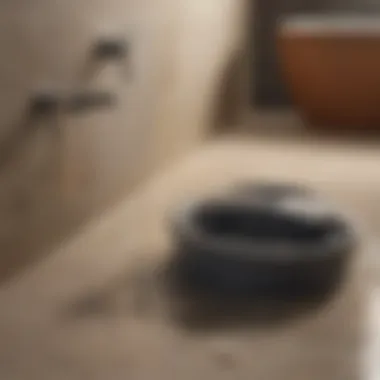Top Products to Effectively Unclog Shower Drains


Intro
Clogged shower drains are a common nuisance for many homeowners and renters. Over time, hair, soap scum, and other debris accumulate, leading to slow drainage and, eventually, clogs. Addressing this issue promptly is essential to maintain a pleasant shower experience. In this guide, we will discuss some of the best products available for unclogging shower drains. We will explore their features, application methods, and effectiveness against various types of clogs.
It is crucial to select the right product for the clog you are facing. Not all clogs are the same, and understanding the nature of the problem can save time and effort in resolving it. From natural remedies to chemical solutions, and even mechanical tools, each option brings its own set of benefits and considerations. Let's delve deeper into these products, detailing their effectiveness, safety, and overall user experience to help you make informed choices for your plumbing needs.
Prologue to Shower Drain Clogs
Understanding shower drain clogs is crucial for maintaining a clean and functional bathroom. Clogs not only disrupt the flow of water but also create an environment conducive to unpleasant odors and moisture-related damages. This section highlights why recognizing and addressing these issues is essential.
Regular maintenance and prompt action can prevent minor blockages from turning into major plumbing problems. Homeowners and renters alike benefit from knowing the common causes of clogs and their impacts on the overall aesthetics of their homes. By being informed, individuals can take proactive steps in selecting the most effective products and methods to address these issues.
Common Causes of Shower Drain Clogs
Shower drains can become clogged for a variety of reasons. Understanding these common causes can assist in preventing future occurrences. Here are a few key factors:
- Hair Accumulation: A significant contributor to shower drain clogs is hair. Over time, strands can accumulate and create a blockage.
- Soap Scum and Residue: Soap buildup can mix with other debris, forming a thicker blockage that does not wash away easily.
- Mineral Deposits: Hard water can cause mineral buildup over time, further restricting water flow.
- Foreign Objects: Items such as small toiletries or personal care products can accidentally fall into the drain and create a clog.
When addressing these root causes, being proactive with cleaning methods becomes essential in mitigating the chances of future clogs.
Impacts of Clogged Drains on Home Aesthetics
Clogged drains can significantly affect the aesthetics of a home. A shower that drains poorly can lead to water pooling, which not only looks unappealing but may also create a breeding ground for mildew and mold. This is important for real estate enthusiasts as it diminishes a home's value and is a concern for tenants who prioritize cleanliness.
- Visual Appeal: Water accumulation in a shower can lead to discoloration and stains, distracting from the overall design and theme of the bathroom.
- Odor Concerns: Standing water may produce unpleasant smells, which can permeate throughout the home.
- Long-Term Damage: Continuous clogs can lead to leaks or other plumbing issues that are costly to repair, ultimately impacting the marketability of a home.
Overall, the aesthetic considerations of clogged drains extend beyond mere appearances, affecting the comfort and functionality of living spaces.
Assessment of Clog Severity
Understanding the severity of a clog is critical in determining the most effective approach for remediation. Without this assessment, homeowners may mistakenly apply inappropriate methods, leading to inefficiencies or further damage. This section aims to outline key indicators of clog severity and the potential implications of ignoring these signs.
Assessing the severity of a shower drain clog entails careful observation and practical evaluation. Factors such as water drainage times, smells, and visible debris should be considered. These signs guide homeowners in selecting the proper tools or methods to address the issue effectively, saving time and resources.
Recognizing Signs of Clogs
Recognizing the signs of a clog is the first step towards an effective solution. Common indicators include slow drainage, water pooling around the drain, and unpleasant odors emanating from the shower area.
- Slow Drainage: If the water does not clear quickly after use, this may suggest the beginning of a blockage.
- Pooling Water: Standing water in the shower indicates a more severe problem that prevents proper flow.
- Odors: Foul smells can point to stagnant water trapped within the drain. This smell may worsen over time.
Each of these symptoms necessitates immediate attention. Ignoring them may result in a more severe clog or even plumbing issues that could require costly repairs.
When to Seek Professional Help
Some situations warrant the involvement of a professional plumber. If a homeowner attempts to clear a stubborn clog with no success after several methods, it may signal a serious underlying issue. Other indicators of needing expert assistance include:
- Frequent Recurrences: Constant clogs can hint at larger plumbing problems that require specialized tools.
- Multiple Drains Affected: If several drains in the home are slow or clogged, this suggests a more systemic issue with the plumbing system.
- Unusual Noises: Sounds like gurgling could indicate air trapped in the pipes, a sign of a deeper clog.
In these cases, consulting a professional can provide both a diagnosis and a long-term solution. Addressing plumbing problems early can prevent minor issues from developing into major disruptions.


Natural Remedies for Unclogging Shower Drains
Natural remedies offer an affordable and eco-friendly approach to unclog shower drains. They provide a gentler alternative to chemical solutions, minimizing the risk of harming pipes or the environment. Homeowners often seek these remedies for regular maintenance or minor clogs before reverting to harsh chemicals. Understanding these remedies can empower individuals against the frustration of persistent blockages that often disrupt daily routines.
The benefits of using natural remedies are manifold. First, they are easy to implement using common household ingredients. Second, they avoid the potentially harmful fumes associated with traditional drain cleaning chemicals. Third, frequent use of natural solutions can slow the buildup of grime and debris, maintaining the integrity of plumbing systems. Finally, many of these methods are cost-effective, appealing to budget-conscious homeowners and renters alike.
Baking Soda and Vinegar Solution
The combination of baking soda and vinegar serves as a well-known remedy for unclogging drains. This solution works due to a simple chemical reaction. When baking soda, a base, comes into contact with vinegar, an acid, it creates fizzing action that can dislodge some clogs without damaging pipes.
To use this solution:
- Pour half a cup of baking soda down the drain.
- Follow with half a cup of vinegar. Optional: add a few drops of dish soap for effectiveness.
- Cover the drain with a cloth or stopper to keep the reaction focused in the pipe.
- Wait for about 15 minutes to let the mixture work.
- Flush the drain with hot water to clear any remaining debris.
This method is especially effective against organic blockages like hair and soap scum. Regular application can maintain drain functionality over time.
Salt and Boiling Water Method
Another effective natural remedy is the salt and boiling water method. Salt acts as a natural abrasive, helping to loosen stubborn blockages, while boiling water can dissolve grease and soap residues.
To apply this method:
- Boil a kettle or pot of water.
- Add a half cup of salt to the boiling water.
- Carefully pour the boiling saltwater directly down the clogged drain.
- Allow it to sit for several minutes, then run hot water to rinse.
This approach works well for minor clogs formed from accumulated soap and grease. Using it a few times monthly can help keep drains clear.
Both of these natural methods offer effective ways to maintain a clog-free shower while being gentle on your plumbing system, promoting a healthy home environment.
Chemical Solutions and Drain Cleaners
In today's fast-paced world, keeping a home unclogged is essential. Chemical solutions and drain cleaners serve a pivotal role in addressing shower drain clogs effectively. They offer a quick and often powerful means to dissolve stubborn blockages, especially those caused by hair, soap residue, and grease. Many homeowners rely on these products, given their ease of use compared to other methods.
Understanding chemical drain cleaners involves knowing their mechanisms. These products usually contain strong chemicals, such as sodium hydroxide or sulfuric acid, designed to break down organic materials. However, it is critical to consider both the potential benefits and the risks associated with their use. Improper application can lead to damage to plumbing or even personal harm. Therefore, informed selection and correct usage are imperative when opting for chemical solutions.
Overview of Chemical Drain Cleaners
Chemical drain cleaners typically fall into three categories: acidic, alkaline, and enzymatic. Each type boasts distinct properties that determine their effectiveness against specific types of clogs:
- Acidic Cleaners: These are potent formulas that quickly dissolve organic matter. They work best for heavy blockages but can be harsh on pipes over time.
- Alkaline Cleaners: Often more common, these solutions generate heat to melt away grime. They can be effective but may require several applications for severe clogs.
- Enzymatic Cleaners: These are gentler options, utilizing enzymes to eat away at organic material. They are safer for plumbing systems but may take longer to work.
For best results, select a cleaner based on the nature of the clog. It's advisable to read labels closely and follow instructions diligently.
Choosing Safe Chemical Products
When selecting chemical drain cleaners, safety must be a priority. Not all products are created equal, and some may contain ingredients that could cause harm to you or your plumbing. Here are key points to consider when making a choice:
- Read the Ingredients: Avoid cleaners with phosphates or chlorine, as these may cause damage to your pipes or harm the environment.
- Look for Eco-Friendly Options: Brands like Bio-Clean offer products designed to minimize environmental impact while still being effective.
- Check for Certifications: Certifications from organizations such as the EPA can provide assurance of a product's safety and effectiveness.
- Consider Your Plumbing System: Older pipes may be more susceptible to damage from harsh chemicals. In such cases, opt for less potent solutions or natural remedies.
Replacing damaging chemical cleaners with safer alternatives can save more than just your plumbing; it can contribute to a healthier home environment.
"The best way to avoid clogs is not just to treat them but to prevent them from happening in the first place."


In summary, while chemical solutions can be an effective means of unclogging shower drains, they require careful consideration and responsible usage. Understanding the types, benefits, and safety of these cleaners ensures that your choices support both your plumbing and your well-being.
Mechanical Tools for Drain Cleaning
The use of mechanical tools for drain cleaning is indispensable in addressing shower drain clogs. Unlike chemical solutions, mechanical tools offer a hands-on approach to unclogging a drain. This section emphasizes various tools available, their benefits, and considerations when selecting an appropriate tool for specific clogs.
Using mechanical tools to clear drains can be more effective for stubborn clogs that resist chemical treatments. Homeowners can tackle many common drain issues without relying solely on potentially harmful chemicals. Furthermore, such tools can be a cost-effective long-term solutions for drain maintenance. However, it is essential to understand the right techniques to ensure proper use and optimize effectiveness.
Plungers: Types and Usage
Plungers are among the most common tools for unclogging showers and sinks. They utilize a simple yet effective strategy, creating suction to dislodge clogs. There are mainly two types of plungers:
- Cup Plunger: This is the traditional style most often used for flat surfaces like sinks. It features a rubber cup at the base, ideal for creating a seal over the drain.
- Flange Plunger: This variation is more suitable for toilets and has a flanged or extended rim that enhances its sealing ability for deeper drains.
To effectively use a plunger, follow these steps:
- Ensure there is enough water in the shower base to cover the plunger cup.
- Position the plunger over the drain and press down firmly to create a seal.
- Pump the plunger up and down rapidly for about 15-20 seconds.
- Remove the plunger to check if the water flows freely down the drain.
Drain Snakes: Effectiveness and Techniques
Drain snakes, or augers, provide a more mechanical approach to tackling difficult clogs. They consist of a flexible metal coil designed to reach deep into pipes and dislodge blockages. Their effectiveness is notable because they can clear clogs formed by hair, soap, and other debris, which plungers may struggle with.
There are different types of drain snakes:
- Handheld snakes: These are simple tools for minor clogs, requiring manual operation.
- Power augers: These are electric-powered tools for serious clogs, capable of penetrating further into pipelines.
To use a drain snake:
- Insert the end of the snake into the drain until it hits resistance.
- Rotate the handle to navigate past the obstruction.
- Move the snake back and forth to break the clog.
- Withdraw the tool, bringing any debris with it.
Wet/Dry Vacuum Use in Clogs
Another versatile tool for unclogging shower drains is a wet/dry vacuum. These vacuums can efficiently remove clogs by suctioning them out. This option is particularly beneficial for liquid clogs, such as soap scum and grease, which can be challenging to dislodge with other tools.
When using a wet/dry vacuum, it is important to:
- Set the vacuum to the liquid setting.
- Create a tight seal around the drain with the vacuum hose.
- Turn the vacuum on to begin suctioning the clog.
Using these mechanical tools effectively can lead to quick resolutions of clogged shower drains. The right tool can save time and money while ensuring a clean and functional drain system.
Preventive Measures for Shower Drain Maintenance
Maintaining a shower drain is essential for avoiding severe clogs and ensuring proper drainage. Adopting preventive measures can save homeowners both time and money, as preventing clogs is always more efficient than dealing with them after they occur. Not only does regular maintenance enhance functionality, but it also helps in maintaining the aesthetic appeal of bathrooms.
Regular Cleaning Routines
Establishing a regular cleaning routine is one of the most effective ways to keep shower drains in good condition. A simple yet consistent practice can prevent hair, soap scum, and other debris from accumulating.
- Frequency: Clean your drains at least once a month to keep them clear. This includes removing visible debris and flushing the drain with hot water to help dissolve any buildup.
- Cleaning Agents: You can use natural cleaning solutions like lemon juice or vinegar to maintain freshness. For more severe cases, consider using a commercial drain cleaner. Just be cautious about the chemical composition if choosing a chemical cleaner, as strong agents can damage pipes over time.
- Inspection: Take a few minutes during each cleaning to inspect the drain for any signs of trouble, such as slow draining or unusual odors. Catching problems early can prevent significant issues in the future.


Using Drain Screens and Traps
The installation of drain screens or traps is a straightforward yet effective preventive measure. These tools prevent hair, soap particles, and other debris from entering the drain.
- Types of Screens: Different types of screens are available, including mesh and solid designs. While mesh strains hair and small particles, solid screens can capture larger debris.
- Installation: Screens are often easy to install and do not require extensive tools or skills. They should fit snugly over the drain to ensure maximum protection.
- Cleaning the Screens: Regular cleaning of the screens is also necessary. Remove them and rinse under hot water to ensure optimal performance without any clogging over time.
"The use of drain screens significantly reduces the amount of debris that can accumulate in pipes, allowing for smoother drainage and less frequent clogs."
By incorporating these preventive measures into maintenance routines, homeowners can effectively minimize the risk of clogged shower drains. It not only ensures smooth functioning but also contributes to a cleaner, more attractive bathroom environment.
Evaluating Product Efficacy
When dealing with clogged shower drains, the importance of evaluating product efficacy cannot be overstated. It serves as a crucial step in selecting the right solution for your clog issues. Understanding how well a product works under various conditions can save time, effort, and money. Homeowners and renters alike face the challenge of ensuring that their living spaces remain functional and appealing. Effectively unclogging a drain is part of this process, making the evaluation of products vital.
It is important to consider several factors when assessing products for unclogging drains. Effectiveness is the foremost concern. A product may claim to resolve clogs but often falls short in real-world applications. Therefore, it is prudent to research user experiences and expert opinions.
Additionally, safety and potential harm to plumbing systems are critical. Some chemicals can damage pipes if misused, leading to costly repairs. Environmental impact should also be taken into account. Many consumers prefer eco-friendly solutions that do not harm the surrounding environment.
By evaluating these key elements, consumers can make informed decisions about which products will suit their particular needs in maintaining a clean and unclogged shower drain.
"Choosing the right unclogging solution not only affects the immediate issue but can also impact your plumbing over the long term."
User Reviews and Testimonials
User reviews present valuable insight into the efficacy of clog-removal products. First-hand experiences can reveal how effective a product truly is compared to its marketing claims. Many shoppers look to platforms such as Amazon or specialized plumbing forums for feedback.
When reading testimonials, consider the following factors:
- Duration of Use: How long users have employed the product can indicate reliability.
- Type of Clog Encountered: Different products may work better for hair, soap residue, or other materials.
- Ease of Application: Reviews often detail how easy or difficult it is to use a product.
By gathering and comparing this information, consumers can better understand which products provide genuine results.
Comparative Analysis of Popular Products
In the crowded marketplace of drain unclogging solutions, conducting a comparative analysis is essential. Various products claim to provide results, but their effectiveness can vary significantly. Here’s a brief overview of some popular options:
- Drano Max Gel: This chemical product is known for its strong formula. Users often report quick results for tough clogs. However, caution is advised due to its chemical composition.
- Baking Soda and Vinegar: A natural remedy favored for its eco-friendliness. Many users appreciate its effectiveness for minor clogs, though it may not work for heavy blockages.
- FlexiSnake: A mechanical tool that allows homeowners to manually remove clogs. Users find it helpful for hair clogs in particular.
In summary, comparing efficacy, user feedback, and safety when evaluating different products will enable more precise decisions. Each option comes with its strengths and weaknesses that should be considered based on the specific needs of the user.
Finale and Summary
Choosing the Right Product for Your Needs
When it comes to choosing the right product for unclogging shower drains, several factors should be considered. First, assess the type of clog you are dealing with. Is it a minor blockage caused by hair, or is it a more severe situation due to accumulated debris? Understanding the nature of the clog can guide you to the right solution.
Some users may find chemical drain cleaners like Drano to be effective for tougher clogs, but one must be cautious as these solutions can be harmful to pipes if used excessively. On the other hand, individuals favoring eco-friendly products can opt for natural remedies such as baking soda and vinegar, which are widely acknowledged for their gentle yet effective action on minor blockages.
Mechanical tools like a plunger or drain snake may also offer immediate resolution without the side effects of chemicals. These options not only clear clogs but can also serve as a preventive measure against future issues, making them versatile for regular maintenance.
Final Thoughts on a Clog-Free Shower Experience
Achieving a clog-free shower experience goes beyond the act of unclogging itself. It involves adopting regular maintenance routines and understanding the products that best serve your plumbing needs. By implementing preventive measures, like using drain screens and maintaining cleaning routines, one can significantly reduce the likelihood of future clogs.
Remember that the journey to a well-maintained drain does not end with the removal of a clog. Continually evaluating the products you use and the efficacy of your chosen methods will improve the longevity of your plumbing system. A clean and functional shower not only enhances the overall aesthetic of your bathroom but also contributes to a more pleasant and hygienic living space.
It is essential to choose products that align with your specific needs, maintaining both functionality and safety in your home environment.







